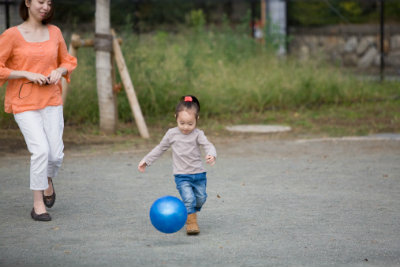 When people think about what’s important to develop in children before they start school, they often think about children learning to count and the alphabet, and other academic-related pursuits. Those are very important skills—but much of early learning takes place through the development of the child’s body, called their motor skills. There are two main types of motor development: gross and fine—and both are crucial.
When people think about what’s important to develop in children before they start school, they often think about children learning to count and the alphabet, and other academic-related pursuits. Those are very important skills—but much of early learning takes place through the development of the child’s body, called their motor skills. There are two main types of motor development: gross and fine—and both are crucial.
Gross Motor Development
As a high level, gross motor skills are those typically used in a gym class or during playground games. These large-muscle activities include running, jumping, climbing, skipping, throwing balls and more, and they involve the use of arms, legs and torso. Your child uses large muscles to get in and out of bed, to climb stairs, to get in and out of the bathtub and much more.
And, as SchoolSparks.com points out, even though gross motor development focuses on the large muscles, they can involve small movements of these muscle groups. For example, if you’ve ever seen a child shift his or her weight and then accidentally slip out of a chair, this was caused by a relatively small movement of a large muscle.
To accelerate this type of motor skills development, encourage your child to participate in activities such as these: have your child start “marching in a straight line. Once he is comfortable with that basic skill, direct him to march forward while tapping his left knee with his right hand and his right knee with his left hand.”
You can also roll a large ball toward your child while he or she stands in place outdoors. Ask him or her to kick the ball when it arrives without stopping its motion. Then, as your child gains competence in this skill, have him or her run toward the ball and kick it without stopping its motion. As with anything, the more fun you can make these activities, the more your young child will want to participate.
Fine Motor Development
Fine motor skills are needed so your child can wash his or her hands, zip the zipper on a jacket, brush teeth and much more. They also serve as the foundation of school work because fine motor skills are needed to hold a crayon or pencil, as just one example.
Parents.com shares tips on how to help spur development of fine motor skills in your young child. First among them is to provide your child with items such as blocks that can be manipulated as “imagination dictates.” Excellent choices of blocks include those that interlock, plus Tinker Toys, Legos and the like. Fun art projects also help a child to develop these skills, so provide him or her with crayons, washable, non-toxic markers and paints, modeling clay, safety scissors, paste, glue, coloring books, construction paper and the like. Safeguard clothing with smocks and let your child enjoy the process of creating!
Yes, this will probably get messy, but try to impose as little control as possible during the process. When your child is finished, try to avoid asking, “What is that?” because young children naturally focus more on the process than the end results. Instead, ask how creating art felt—and then listen to the answers.
Horizon Focuses on Motor Skills Development
As we always say, rain or shine, we keep them moving! We have great gym facilities along with age-appropriate playgrounds. Plus, we offer field trips and other off-site opportunities that allow your child to have fun while developing gross and fine motor skills alike. If you’re ready to talk about our exceptional child care programs, please give us a call at 440-779-1930 today.







